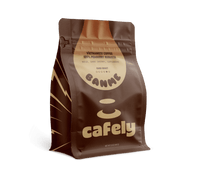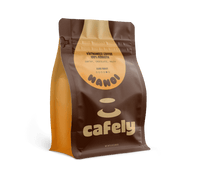When you reach for your morning coffee, do you ever wonder why it's often called a "cup of joe?" We'll dig into this nickname's historical and cultural origin theories and try to figure out how and when this curious phrase developed for our beloved brew.
Why Do We Call Coffee "Joe"?

“Cup of joe” is widely used today to refer to coffee, but how it came to be remains a bit of a mystery. The earliest appearance of the term in print dates back to the 1930s in the United States.
In 1932, Erdman wrote in the Reserve Officer’s Manual: “Jamoke, Java, Joe. Coffee. Derived from the words Java and Mocha, where originally the best coffee came from” [1].
This is one of the earliest examples of the idiom in print. However, the phrase's origins date even further back.
There are five leading theories about the first use of “joe” for coffee:
- In 1914, the Secretary of the Navy, Josephus Daniels, prohibited alcohol on naval vessels. The sailors consumed much more coffee and called it "joe" as a jab at Daniels.
- Others believe the term originated from Martinson Coffee's owner, Joe Martinson, who referred to his popular drink as a "cup of joe."
- The third theory we'll explore is that it's a shortened version of two slang terms for coffee: jamoke and Java.
- It could have come from “cup of George”, referring to the brand of instant coffee drunk by US soldiers in the trenches of WWI.
- Some believe that coffee, a “common man’s drink”, needed a common man’s name.
Let’s look at each one in more detail.
1. The Josephus Daniels Theory
One of the most well-known explanations traces the phrase to Josephus Daniels, the Secretary of the Navy during the First World War. In 1914, Daniels banned alcohol on naval vessels under General Order 99, making coffee the strongest drink on board.
As the story goes, disgruntled sailors started begrudgingly referring to it as a cup of Josephus Daniels or “Joe” as a dig at their boss.
However, not everyone buys into this theory.
This is largely because the timing doesn’t add up. “Cup of Joe” didn’t appear in print until years after Daniels left office, and there’s no direct evidence that Daniels’ policies inspired the word.
The theory is colorful, but it might be more folktale than fact.
Find more fun coffee-related facts here: 105 Coffee Facts: History, Health, & Trivia.
2. The Martinson Coffee Theory
Another theory links the name ‘Joe’ to a particular brand — Martinson Coffee, founded by Joe Martinson in New York in 1898.
According to Martinson Coffee, the brand’s coffee became so popular thanks to Martinson’s marketing efforts that people would refer to their cup as “a cup of Joe,” which may have helped proliferate the nickname.
3. The Linguistic Theory: "Joe" as a Shortening of "Jamoke"
A more linguistically-based theory proposes that “joe” came from “jamoke,” a slang word consisting of “java” (another name for coffee deriving from the island of Java) and “mocha” (a coffee style from Mocha, Yemen).
It then became common to drop the ‘am’ when referring casually to “jamoke", and “joe” might have led to a convenient, catchy short-hand for coffee.
Many coffee experts and historians believe this is the most likely origin of the phrase.
4. Morphed From “A Cup of George” in the WWI Trenches

The fighting in the trenches in World War I was pretty grim. Cold, wet, and outright dangerous, US soldiers needed something that would perk them up.
Enter their rations of coffee, manufactured by a company known as the G. Washington Refining Co., whose founder, George Washington (not the president), had perfected the art of instant coffee. It was so quick and convenient to use that tons of the stuff was shipped off to parched soldiers on the Western Front.
Initially, soldiers referred to the drink as a “cup of George,” although it’s believed over time, this got shortened to “cup of Geo” and could have slipped into “Joe” from there.
Another wartime theory posits that it could have come from “G.I. Joe,” a nickname for US soldiers. Coffee was such an integral part of army rations that the two became linked.
5. Coffee as the "Average Man's Drink"
Another is that Joe simply refers to “the ordinary person,” much like “Joe Public” or “average Joe.” The term “cup of joe” could have emphasized coffee’s role as the common man’s drink.
Cultural Impact Post-1930s
Once “Cup of Joe” had established itself in the American vernacular, it began to pop up in books and magazines, advertisements, and movies.
By the middle of the 20th century, it had become a symbol for much more than coffee itself; it had become a symbol of home and a soothing daily ritual.
As American culture spread across the globe, so did its linguistic peculiarities. Today, “Cup of Joe” is an internationally recognized expression of coffee’s cross-cultural appeal.
The idiom since been used in various movies and television shows, including Band of Brothers, Glee, and Law and Order: Special Victims Unit.
Comparison with Other Coffee Nicknames
"Cup of joe" isn't the only nickname for coffee, but it is one of the most popular.
Here are some other common coffee nicknames and a bit about their origin story:
- Java coffee: A nod to the Indonesian island of Java, where coffee was cultivated initially at scale.
- Brew: Some people call coffee “brew,” but it is also used for tea.
- Go Juice: This nickname references the energy-boosting effects of caffeine.
- Bean Juice: A reference to coffee's origin from coffee beans.
- Cuppa: According to the Oxford English Dictionary, the first known use of “cuppa” was in England in the 1920s.
Coffee Consumption Trends in the US.
Coffee is such an integral part of US culture that we thought we would end with some statistics about your "cup of joe."
- Coffee remains a staple of American life. According to Drive Research, 73% of Americans consume coffee daily [2].
- In 2024, the National Coffee Association also reported that coffee consumption was at a two-decade high [3].
- The report also found that 57% of Americans had consumed a specialty coffee beverage in the last week, a 7.5% increase from the previous year [3].
Just as popular as he was back then, it seems like “Joe” is sticking around with us for a long time to come!
Related: Coffee Statistics, Consumer Trends, & Key Takeaways [2024]
FAQs: Coffee Nicknames

Still curious about the etymology of coffee and its nicknames? Take a look at some more interesting tidbits below.
1. What Does "Cup of Joe" Mean?
“Cup of joe” is a popular, informal nickname for a cup of coffee.
2. Who Was Josephus Daniels, and How Is He Related to the Term "Cup of Joe"?
Josephus Daniels was the Navy Secretary who banned booze from ships in 1914. One theory traces the original meaning of the term to him. After banning alcohol, sailors drank a lot more coffee and begrudgingly referred to it as a “cup of joe.”
3. Is "a Cup of Joe" Related to a Specific Type of Coffee?
No, the idiom refers to coffee in general.
4. How Did "Cup of Joe" Become Popular?
Like many terms, it was likely propagated through cultural and linguistic evolution and media representation.
5. What Are Other Common Nicknames for Coffee?
Java, mocha, bean juice, and cuppa are other phrases you’ll hear instead of coffee.
6. Why Is Coffee Sometimes Called "Java"?
Java is an Indonesian island known for its prolific coffee production.
7. What Is the Difference Between "Joe" and “Jamoke"?
Jamoke is an older slang term for Java blended with mocha. Many believe that this is where the term "cup of Joe" came from.
8. How Has the Idiom "Cup of Joe" Influenced Coffee Culture?
It reflects the casual, everyday nature of coffee consumption and makes coffee approachable and relatable.
9. Can "Cup of Joe" Be Used in Formal Settings?
This phrase is usually used in more casual contexts. In formal settings, coffee is the preferred term.
10. What Impact Did Prohibition Have on the Term "Cup of Joe"?
When alcohol was prohibited, coffee consumption grew. This may have helped popularize the phrase as more people were drinking it.
References
- States., U., & Robert Park Erdman. (1932). Reserve Officer’s Manual, United States Navy.
- Allen, L. (2024, February 1). 2024 Coffee Statistics: Consumption, Preferences, & Spending. Drive Research.
- National Coffee Association. (2024, April 11). Daily coffee consumption is at a 20-year high, up nearly 40%. National Coffee Association.












